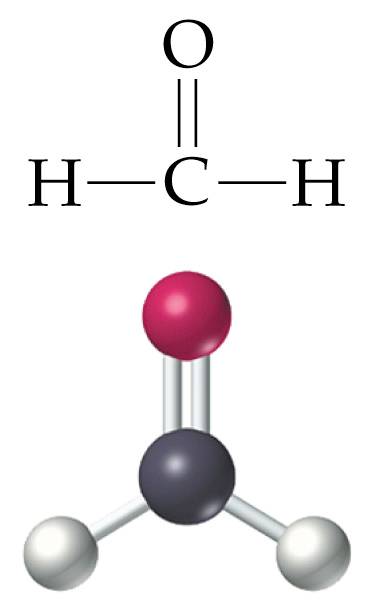February 14, 2005
Formaldehyde—It’s Everywhere!
By Michael D. Shaw
Look anywhere in your home or workplace–at the wood products, paint, drapery, carpets, paper, and insulation materials–to name just a few items. These familiar fixtures of our daily lives all contain formaldehyde, a colorless, pungent-smelling gas that can cause numerous nasty health effects. Relatively low concentrations of formaldehyde can cause searing eye irritation, skin rashes, and a host of respiratory symptoms.
You’d think that we should just get rid of this ubiquitous compound, deemed a “probable carcinogen” by health agencies, but its potential dangers are trumped by its great usefulness! It is part of the adhesive in pressed wood products, a preservative in some paints, a coating in most fabrics, a binder in insulation, and it adds wet strength to certain paper goods.
Environments can become contaminated with this chemical due to excessive moisture, natural outgassing from the materials themselves, and overzealously sealed-up buildings, otherwise known as inadequate ventilation. In practice, it does not take much to create a potentially hazardous situation, especially in modern workplaces with windows that don’t open.
Since, in theory at least, we can increase ventilation, and watch out for excessive moisture, what, if anything can be done to limit the outgassing of formaldehyde? In other words, how can we control the source?
First of all, any formaldehyde-treated product will tend to emit less gas with time. So, the initial good news is that the problem will always decrease, even if we do nothing. Experience has shown that the worst offenders are typically manufactured wood products (including particleboard and medium density fiberboard) and most types of carpet padding. Any new delivery of such items should be accompanied by enhanced ventilation, ideally running 24 x 7 for the first few weeks of installation. Note that these days, virtually any piece of furniture or cabinetry should be regarded as a “manufactured wood product” unless you are absolutely sure that it is constructed only of real wood.
Sometimes, products touted as “real wood” contain significant amounts of hardwood-veneer plywood or particleboard, and could still have a goodly amount of urea-formaldehyde or phenol-formaldehyde resins, that can outgas formaldehyde.
While standards are in place regulating the amount of formaldehyde that can be released by several products, including manufactured wood items, the consumer is nonetheless well advised to follow our recommendations on enhanced ventilation, as outlined above. Bear in mind, also, that emissions will increase with temperature, so use your air conditioning to keep room temperature in check, upon delivery of affected items in hot weather.
For the do-it-yourself crowd, we recommend “exterior-grade” plywood and other manufactured wood, since this classification assures you of lower formaldehyde emissions.
Absent an active formaldehyde source to contaminate the environment, ambient levels of the compound are well below 0.06 ppm (parts-per-million), in both outdoor and indoor air. Depending on the sensitivity of the particular individual, health effects can occur at concentrations as low as 0.1 ppm, and fatalities have been observed at less than 100 ppm. Severe exposures can have long-term or even irreversible effects.
Once formaldehyde is identified as the culprit in an environment, remediation is possible, and might range from short-term super-ventilation to removal of the offending materials. As always, prevention is preferable. Be more critical of items you bring into your home or workplace, and never trade energy savings (in the form of poor ventilation) for health. Sensitive individuals should simply avoid blown-in insulation in favor of alternative products, and everyone should limit smoking in their home or office, a practice which makes ANY indoor air quality situation worse.
As a biochemist and trained professional concerning the monitoring of formaldehyde, I have observed the effects of formaldehyde contamination in both homes and workplaces. In most cases, simple and inexpensive preventive techniques would have eliminated these problems.
A technological society must learn how to coexist with compounds, such as formaldehyde, that offer many benefits, as well as health challenges, if we are to improve the quality of life for all of our citizens.

